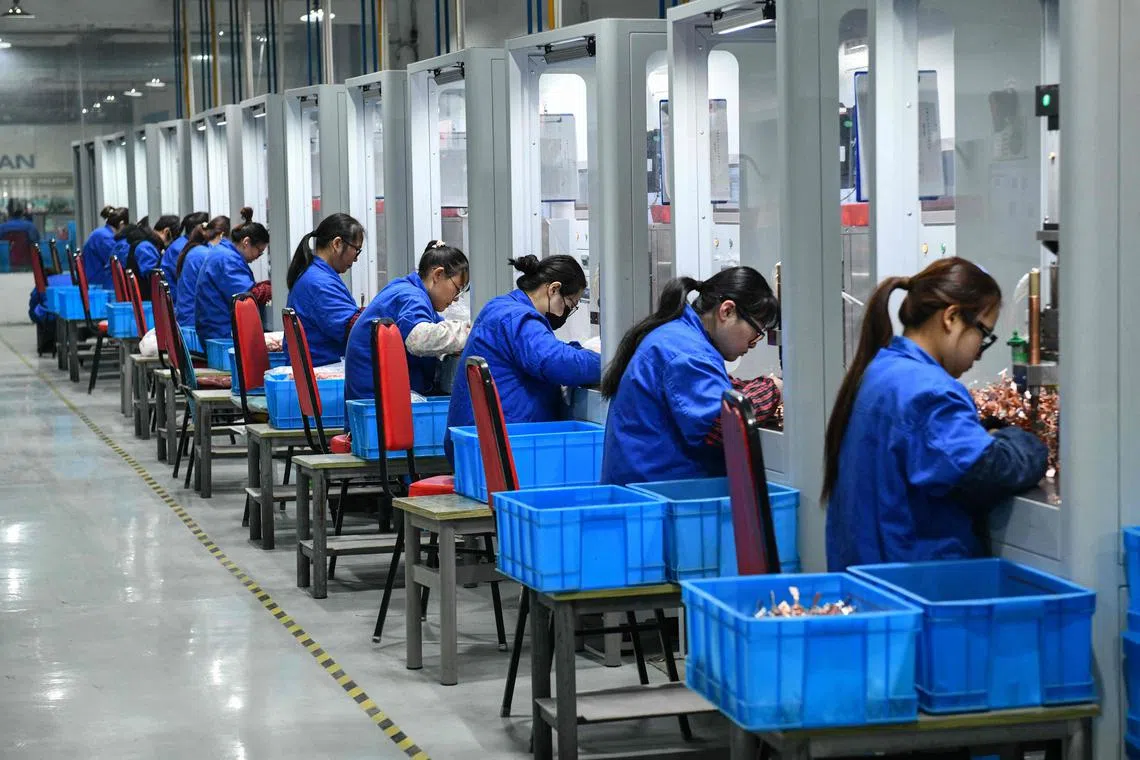China factory activity shrinks again with economy hurt by weak demand
Sign up now: Get ST's newsletters delivered to your inbox

The official manufacturing purchasing managers index reached 49.2 in January, the National Bureau of Statistics said.
PHOTO: AFP
Follow topic:
BEIJING – China’s factory activity contracted for a fourth straight month in January as new orders shrank, suggesting weak demand continues to hamper the economy ahead of the upcoming Lunar New Year holiday.
The official manufacturing purchasing managers index (PMI) reached 49.2 in January, the National Bureau of Statistics said in a statement on Jan 31 – above December’s reading
The number was slightly worse than what economists expected.
A gauge of non-manufacturing activity – which measures the construction and services sectors – was 50.7, up from December and marginally better than projections from economists.
A sub-index of services activity rebounded to 50.1, the first expansion since October, though growth in construction eased to a three-month low.
“There is no signal of a turning point here,” said Mr Galvin Chia, an emerging market strategist at NatWest Markets in Singapore. “The surprises are too small to change what is already a very entrenched bearish view on the outlook.”
Market reaction to the PMIs was muted, with the onshore benchmark CSI 300 Index down slightly in morning trade. A gauge of China stocks listed in Hong Kong lost as much as 1.1 per cent.
Both indexes are very close to wiping out gains from last week, which had been spurred by hopes of stronger government support.
The offshore yuan was little changed, while China’s 10-year government bond yield dropped to 2.43 per cent, the lowest since 2002.
The Australian dollar – which is risk-sensitive and seen as a proxy for China – declined 0.6 per cent.
The world’s second-largest economy has been trying to regain momentum in 2024 after the government introduced some stimulus.
That has included measures to unleash more long-term cash for banks, tighten rules on the lending of shares for short selling and broaden developer access to loans.
The authorities ramped up rhetoric last week in a bid to stem a rout that has wiped out some US$6 trillion (S$8 trillion) in value in stock markets.
While still in contraction, the slight rise in the manufacturing gauge “suggests sentiment in the economy has had some improvement”, said NBS analyst Zhao Qinghe in a statement accompanying the PMI release.
Mr Zhao pointed to some positive signs for foreign demand, given the increase in a sub-gauge of new export orders to 47.2 – still well in contraction, though the best reading in four months.
The start of the year is generally a slower season for manufacturers in the lead-up to the Lunar New Year, a week-long holiday that will take place in February, during which factory activity comes to a standstill.
Even so, the underperformance of the headline manufacturing gauge suggests underlying weakness in the economy, according to Mr Bruce Pang, chief economist at Jones Lang Lasalle.
“Seasonality alone cannot fully explain the sluggishness of the manufacturing PMI,” he said.
“Policy support is still needed to boost the effective demand in the society to maintain a sustainable recovery.”
Economists expect Beijing to announce a fairly ambitious growth goal for 2024 when the national legislature meets in March.
The economy hit an official government growth goal of around 5 per cent in 2023, but maintaining a similar rate of expansion in 2024 may be challenging.
The base of comparison will be higher, and the economy no longer has the benefit of a boost from the release of pent-up demand immediately post-pandemic.
Main drags on growth also remain, with the real estate slump showing no signs of ending and price drops continuing.
Trade tensions with major partners are intensifying over key exports, including electric cars, adding to the downside risks facing the economy. BLOOMBERG

